clock RENAULT CLIO 2009 X85 / 3.G Owners Manual
[x] Cancel search | Manufacturer: RENAULT, Model Year: 2009, Model line: CLIO, Model: RENAULT CLIO 2009 X85 / 3.GPages: 264, PDF Size: 15.68 MB
Page 37 of 264
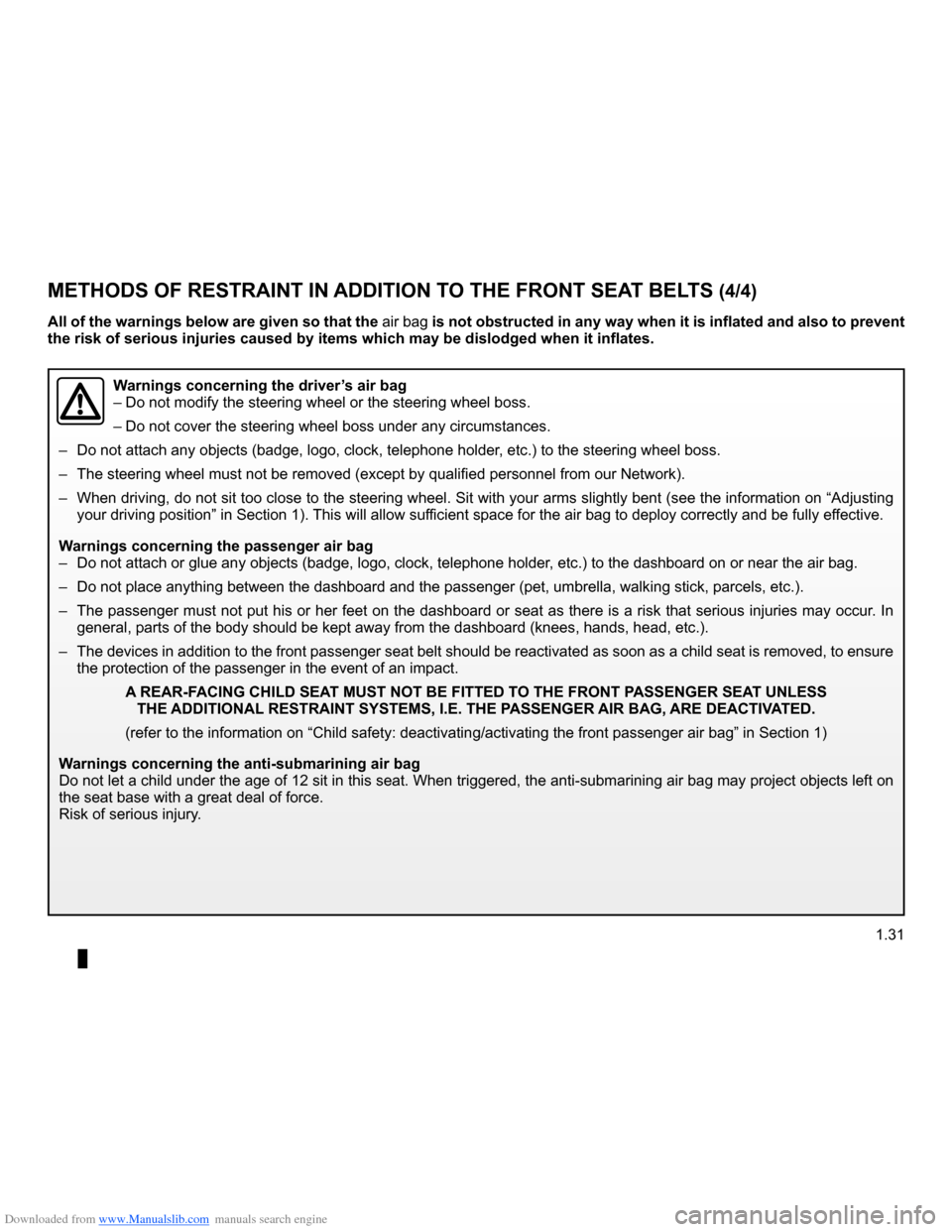
Downloaded from www.Manualslib.com manuals search engine
child safety.............................................................(current page)
JauneNoirNoir texte
1.31
ENG_UD14662_2Dispositifs complémentaires à la ceinture avant (X85 - B85 - C85 \
- S85 - K85 - Renault)ENG_NU_853-3_BCSK85_Renault_1
METHODS OF RESTRAINT IN ADDITION TO THE FRONT SEAT BELTS (4/4)
All of the warnings below are given so that the air bag is not obstructed in any way when it is inflated and also to prevent the risk of serious injuries caused by items which may be dislodged when\
it inflates.
Warnings concerning the driver’s air bag
– Do not modify the steering wheel or the steering wheel boss.
– Do not cover the steering wheel boss under any circumstances.
– Do not attach any objects (badge, logo, clock, telephone holder, etc.) to the steering wheel boss.
– The steering wheel must not be removed (except by qualified personnel from our Network).
– When driving, do not sit too close to the steering wheel. Sit with your arms slightly bent (see the information on “Adjusting
your driving position” in Section 1). This will allow sufficient space for the air bag to deploy correctly and be fully effective.
Warnings concerning the passenger air bag
– Do not attach or glue any objects (badge, logo, clock, telephone holder, etc.) to the dashboard on or near the air bag.
– Do not place anything between the dashboard and the passenger (pet, umbrella, walking stick, parcels, etc.).
– The passenger must not put his or her feet on the dashboard or seat as there is a risk that serious injuries may occur. In
general, parts of the body should be kept away from the dashboard (knee\
s, hands, head, etc.).
– The devices in addition to the front passenger seat belt should be reactivated as soon as a child seat is removed, to ensure
the protection of the passenger in the event of an impact.
A REAR-FACING CHILD SEAT MUST NOT BE FITTED TO THE FRONT PASSENGER SEAT UNLESS THE ADDITIONAL RESTRAINT SYSTEMS, I.E. THE PASSENGER AIR BAG, ARE DEACTIVATED.
(refer to the information on “Child safety: deactivating/activating \
the front passenger air bag” in Section 1)
Warnings concerning the anti-submarining air bagDo not let a child under the age of 12 sit in this seat. When triggered, the anti-submarining air bag may project objects left on the seat base with a great deal of force.Risk of serious injury.
Page 75 of 264
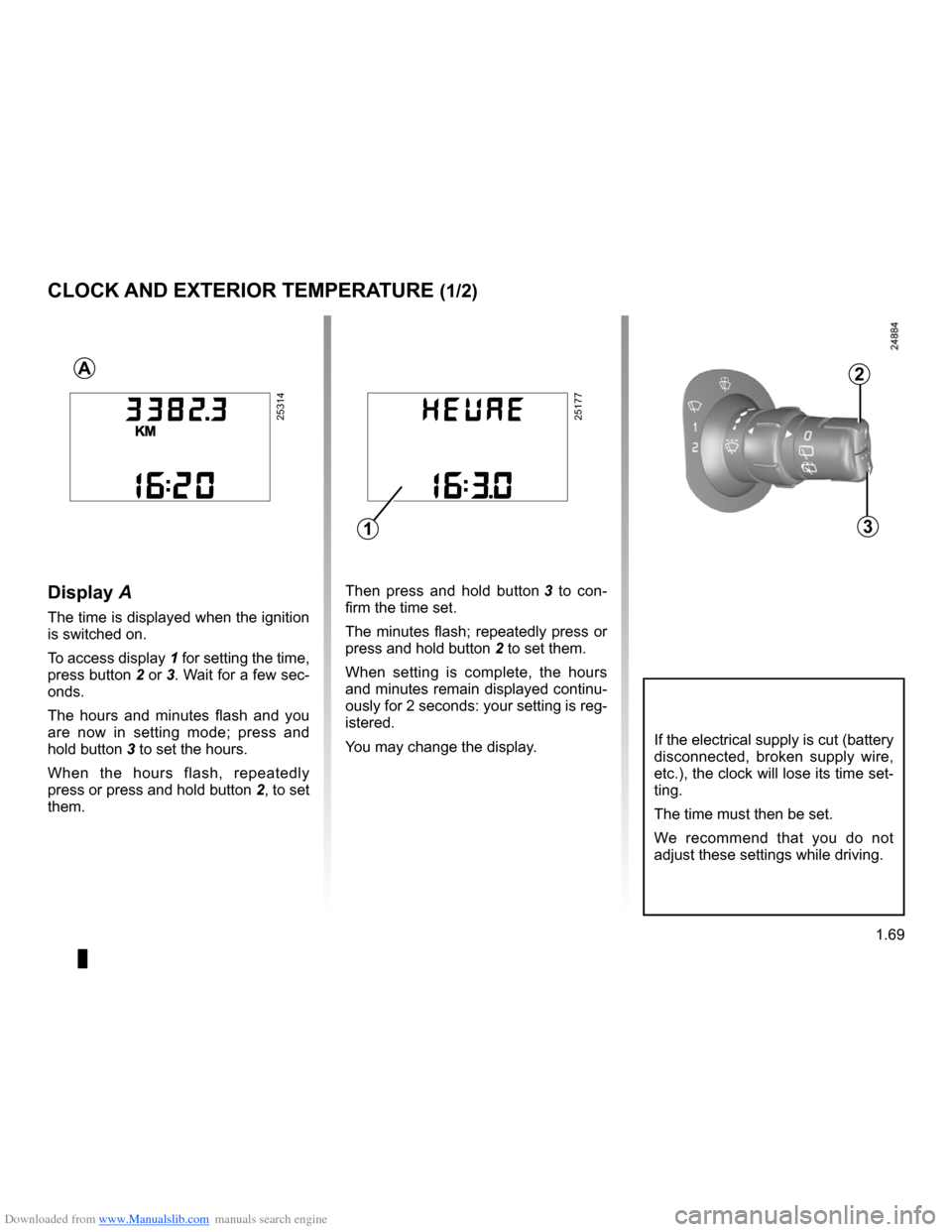
Downloaded from www.Manualslib.com manuals search engine
clock .....................................................(up to the end of the DU)clock .....................................................(up to the end of the DU)control instruments ...............................(up to the end of the DU)
1.69
ENG_UD10538_1Heure (X85 - B85 - C85 - S85 - K85 - Renault)ENG_NU_853-3_BCSK85_Renault_1
Clock and exterior temperature
If the electrical supply is cut (battery disconnected, broken supply wire, etc.), the clock will lose its time set- ting.
The time must then be set.
We recommend that you do not adjust these settings while driving.
251772531425314
Then press and hold button 3 to con- firm the time set.
The minutes flash; repeatedly press or
press and hold button 2 to set them.
When setting is complete, the hours and minutes remain displayed continu- ously for 2 seconds: your setting is reg- istered.
You may change the display.
Display A
The time is displayed when the ignition is switched on.
To access display
1 for setting the time,
press button 2 or 3. Wait for a few sec- onds.
The hours and minutes flash and you are now in setting mode; press and
hold button 3 to set the hours.
When the hours flash, repeatedly
press or press and hold button 2, to set them.
CLOCK AND EXTERIOR TEMPERATURE (1/2)
A2
31
Page 76 of 264

Downloaded from www.Manualslib.com manuals search engine
external temperature .............................................(current page)
1.70
ENG_UD10538_1Heure (X85 - B85 - C85 - S85 - K85 - Renault)ENG_NU_853-3_BCSK85_Renault_1
Vehicles fitted with navigation aid systems, telephones, etc.
Refer to the separate instructions for the function to understand the special features of this equipment.
External temperature
indicator
Special note:
When the outside temperature is –3°C to +3°C, the °C characters flash (signal- ling a risk of ice on the road).
If the electrical supply is cut (battery disconnected, broken supply wire, etc.), the clock will lose its time set- ting.
The time must then be set.
We recommend that you do not adjust these settings while driving.
External temperature in- dicator
As ice formation is related to climatic exposure, local air humidity and temperature, the external temperature alone is not sufficient to detect ice.
Display B
The display B shows:
– the radio;
– the time;
– the exterior temperature.
The time and/or external tempera- ture are displayed when the ignition is switched on.
Resetting the clock
Press button:
H for the hours, M for the minutes.
CLOCK AND EXTERIOR TEMPERATURE (2/2)
B
H
M
Page 188 of 264
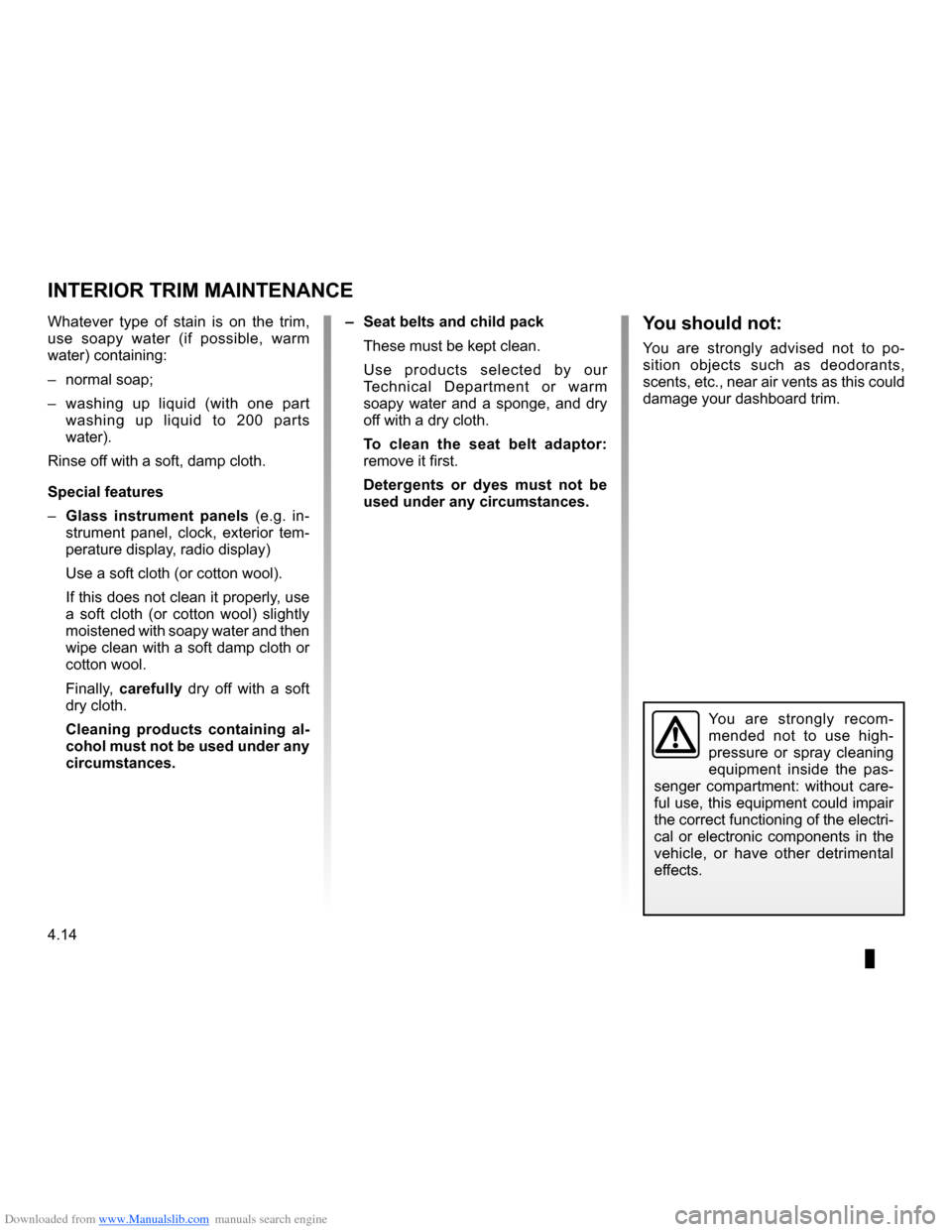
Downloaded from www.Manualslib.com manuals search engine
maintenance:interior trim ......................................(up to the end of the DU)interior trimmaintenance ...................................(up to the end of the DU)
4.14
ENG_UD14671_2Entretien des garnitures intérieures (X85 - B85 - C85 - S85 - K85 - \
Renault)ENG_NU_853-3_BCSK85_Renault_4
Interior trim maintenance
y ou should not:
You are strongly advised not to po- sition objects such as deodorants, scents, etc., near air vents as this could damage your dashboard trim.
–
Seat belts and child pack
These must be kept clean.
Use products selected by our Technical Department or warm soapy water and a sponge, and dry off with a dry cloth.
To clean the seat belt adaptor: remove it first.
Detergents or dyes must not be used under any circumstances.
Whatever type of stain is on the trim, use soapy water (if possible, warm water) containing:
– normal soap;
– washing up liquid (with one part
washing up liquid to 200 parts water).
Rinse off with a soft, damp cloth.
Special features
–
Glass instrument panels (e.g. in- strument panel, clock, exterior tem- perature display, radio display)
Use a soft cloth (or cotton wool).
If this does not clean it properly, use a soft cloth (or cotton wool) slightly moistened with soapy water and then wipe clean with a soft damp cloth or cotton wool.
Finally, carefully dry off with a soft dry cloth.
Cleaning products containing al- cohol must not be used under any circumstances.
INTERIOR TRIM MAINTENANCE
You are strongly recom- mended not to use high- pressure or spray cleaning equipment inside the pas- senger compartment: without care- ful use, this equipment could impair the correct functioning of the electri- cal or electronic components in the vehicle, or have other detrimental
effects.
Page 190 of 264
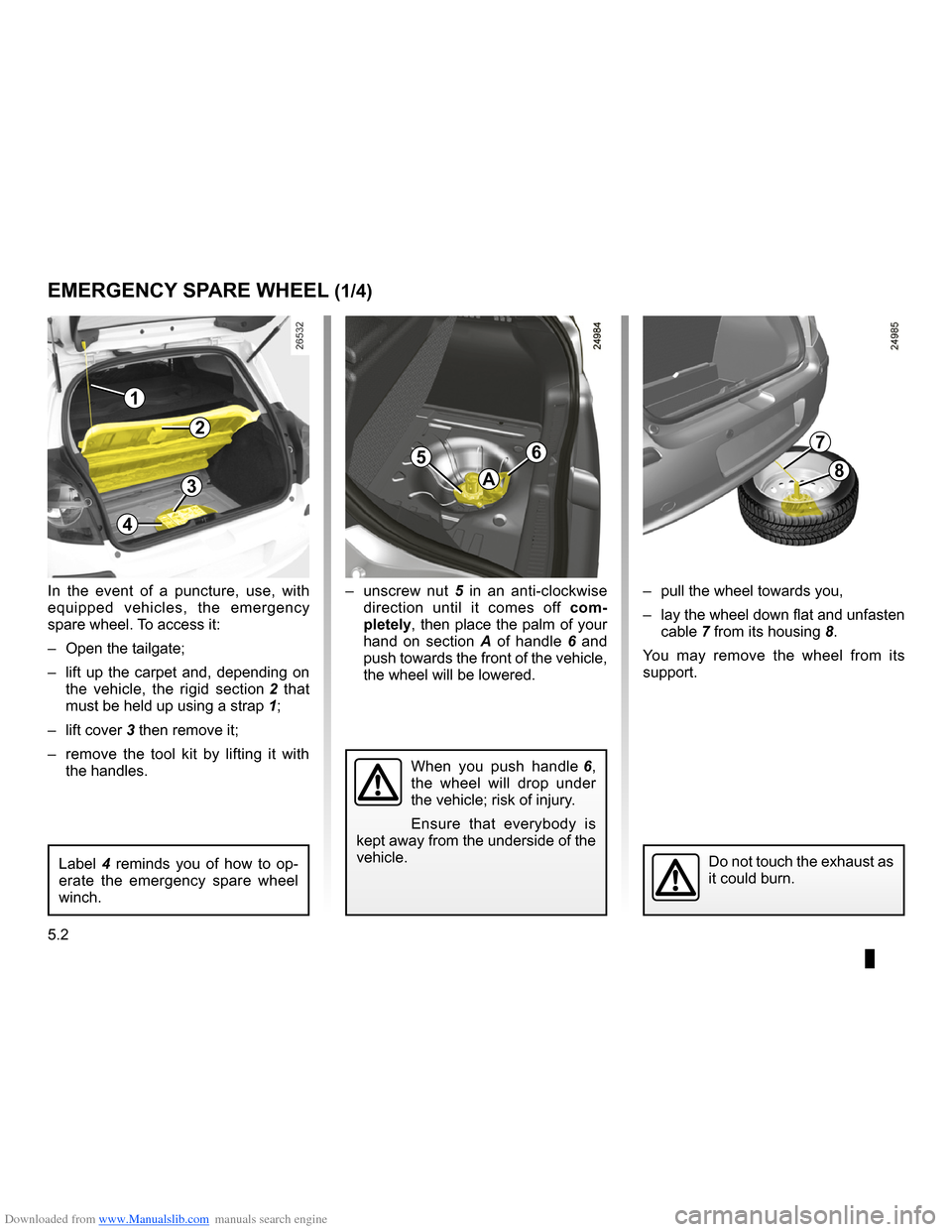
Downloaded from www.Manualslib.com manuals search engine
puncture................................................(up to the end of the DU)emergency spare wheel .......................(up to the end of the DU)
5.2
ENG_UD10596_1Roue de secours (X85 - B85 - C85 - S85 - K85 - Renault)ENG_NU_853-3_BCSK85_Renault_5
JauneNoirNoir texte
– unscrew nut 5 in an anti-clockwise direction until it comes off com- pletely, then place the palm of your hand on section A of handle 6 and push towards the front of the vehicle, the wheel will be lowered.
Emergency spare wheel
Label 4 reminds you of how to op- erate the emergency spare wheel winch.
Do not touch the exhaust as it could burn.
– pull the wheel towards you,
– lay the wheel down flat and unfasten
cable 7 from its housing 8.
You may remove the wheel from its support.
In the event of a puncture, use, with equipped vehicles, the emergency spare wheel. To access it:
– Open the tailgate;
– lift up the carpet and, depending on
the vehicle, the rigid section 2 that
must be held up using a strap 1;
– lift cover
3 then remove it;
– remove the tool kit by lifting it with
the handles.
EMERGENCY SPARE WHEEL (1/4)
1
2
3
4
56
A
7
8
When you push handle 6, the wheel will drop under the vehicle; risk of injury.
Ensure that everybody is kept away from the underside of the vehicle.
Page 217 of 264
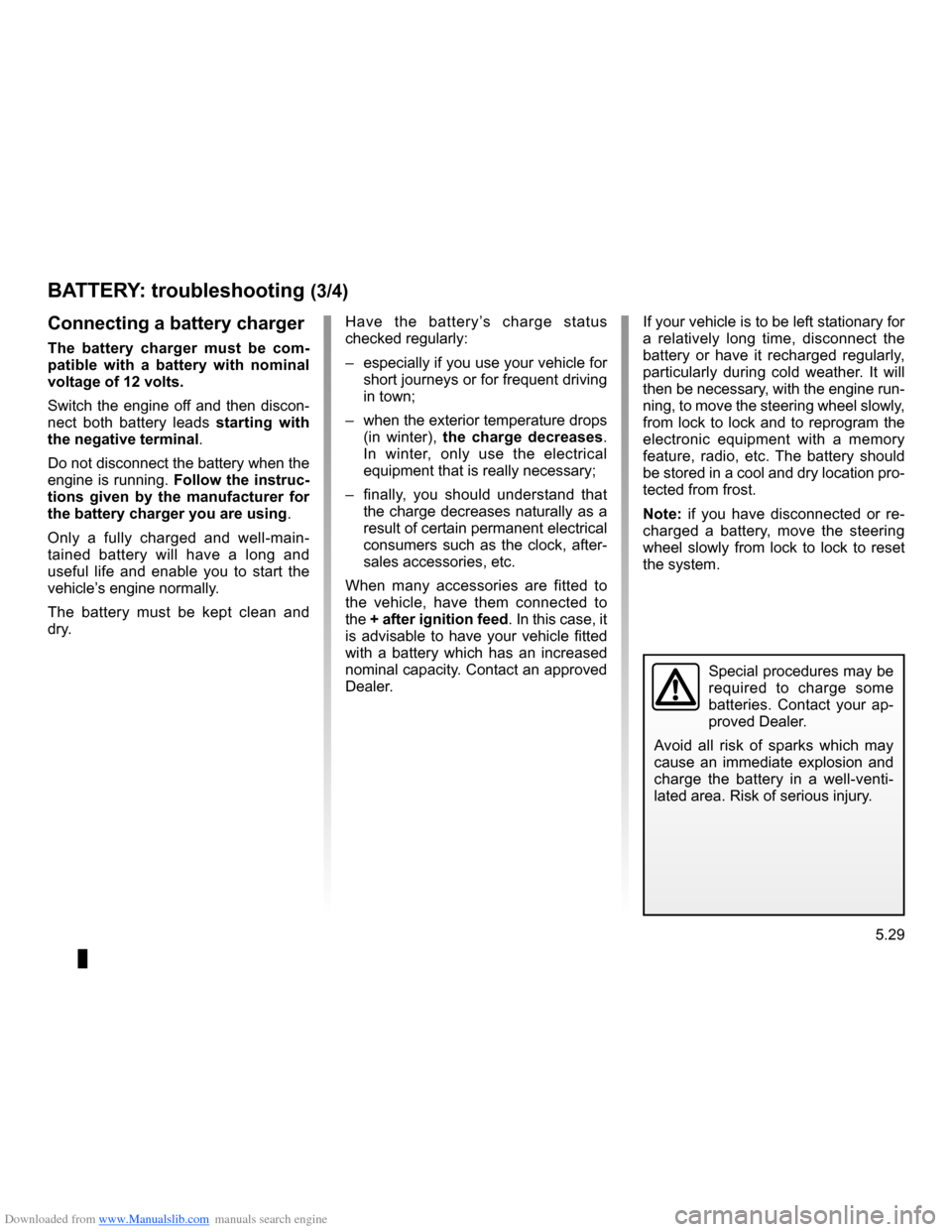
Downloaded from www.Manualslib.com manuals search engine
JauneNoirNoir texte
5.29
ENG_UD12592_2Batterie : dépannage (X85 - B85 - C85 - S85 - K85 - Renault)ENG_NU_853-3_BCSK85_Renault_5
BATTERY: troubleshooting (3/4)
Special procedures may be required to charge some batteries. Contact your ap- proved Dealer.
Avoid all risk of sparks which may cause an immediate explosion and charge the battery in a well-venti- lated area. Risk of serious injury.
If your vehicle is to be left stationary for a relatively long time, disconnect the battery or have it recharged regularly, particularly during cold weather. It will then be necessary, with the engine run- ning, to move the steering wheel slowly, from lock to lock and to reprogram the electronic equipment with a memory feature, radio, etc. The battery should be stored in a cool and dry location pro- tected from frost.
Note: if you have disconnected or re- charged a battery, move the steering wheel slowly from lock to lock to reset the system.
Have the battery’s charge status checked regularly:
– especially if you use your vehicle for
short journeys or for frequent driving in town;
– when the exterior temperature drops
(in winter), the charge decreases. In winter, only use the electrical equipment that is really necessary;
– finally, you should understand that
the charge decreases naturally as a result of certain permanent electrical consumers such as the clock, after- sales accessories, etc.
When many accessories are fitted to the vehicle, have them connected to the + after ignition feed. In this case, it is advisable to have your vehicle fitted with a battery which has an increased nominal capacity. Contact an approved Dealer.
Connecting a battery charger
The battery charger must be com- patible with a battery with nominal voltage of 12 volts.
Switch the engine off and then discon- nect both battery leads starting with the negative terminal.
Do not disconnect the battery when the engine is running. Follow the instruc- tions given by the manufacturer for the battery charger you are using.
Only a fully charged and well-main- tained battery will have a long and useful life and enable you to start the vehicle’s engine normally.
The battery must be kept clean and dry.
Page 257 of 264
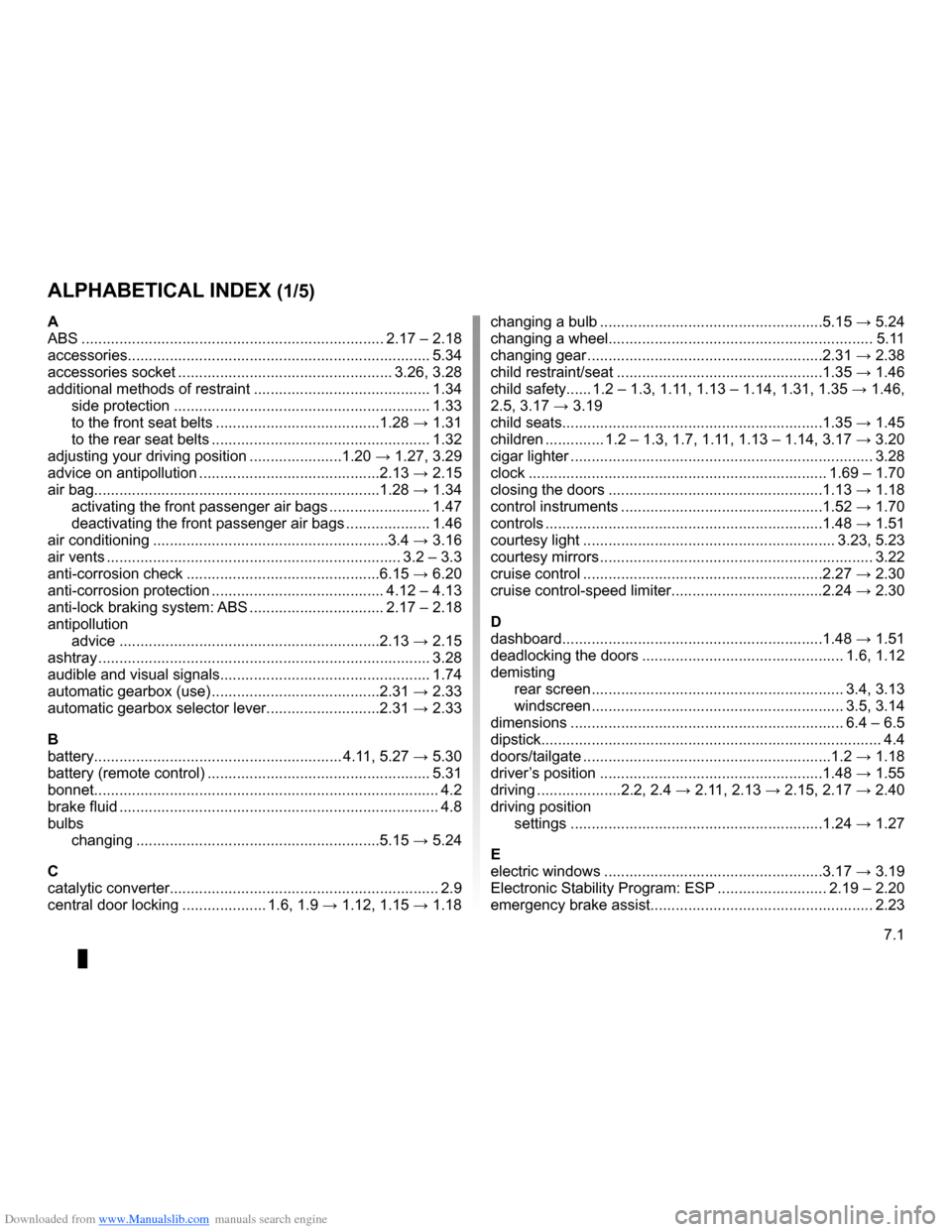
Downloaded from www.Manualslib.com manuals search engine
7.1
FRA_UD14717_4Index (X85 - B85 - C85 - S85 - K85 - Renault)ENG_NU_853-3_BCSK85_Renault_7
changing a bulb .....................................................5.15 → 5.24changing a wheel...............................................................5.11changing gear ........................................................2.31 → 2.38child restraint/seat .................................................1.35 → 1.46child safety...... 1.2 – 1.3, 1.11, 1.13 – 1.14, 1.31, 1.35 → 1.46,
2.5, 3.17 → 3.19
child seats..............................................................1.35 → 1.45children .............. 1.2 – 1.3, 1.7, 1.11, 1.13 – 1.14, 3.17 → 3.20cigar lighter ........................................................................\
3.28clock .......................................................................1.69 – 1.70closing the doors ...................................................1.13 → 1.18control instruments ................................................1.52 → 1.70controls ..................................................................1.48 → 1.51courtesy light ............................................................ 3.23, 5.23courtesy mirrors .................................................................3.22cruise control .........................................................2.27 → 2.30cruise control-speed limiter....................................2.24 → 2.30
Ddashboard..............................................................1.48 → 1.51deadlocking the doors ................................................ 1.6, 1.12demistingrear screen ............................................................ 3.4, 3.13windscreen ............................................................ 3.5, 3.14dimensions .................................................................6.4 – 6.5dipstick........................................................................\
.........4.4doors/tailgate ...........................................................1.2 → 1.18driver’s position .....................................................1.48 → 1.55driving .................... 2.2, 2.4 → 2.11, 2.13 → 2.15, 2.17 → 2.40driving positionsettings ............................................................1.24 → 1.27
Eelectric windows ....................................................3.17 → 3.19Electronic Stability Program: ESP ..........................2.19 – 2.20emergency brake assist.....................................................2.23
AABS ........................................................................\
2.17 – 2.18accessories........................................................................\
5.34accessories socket ................................................... 3.26, 3.28additional methods of restraint ..........................................1.34side protection .............................................................1.33to the front seat belts .......................................1.28 → 1.31to the rear seat belts ....................................................1.32adjusting your driving position ...................... 1.20 → 1.27, 3.29advice on antipollution ...........................................2.13 → 2.15air bag....................................................................1.28 → 1.34activating the front passenger air bags ........................1.47deactivating the front passenger air bags ....................1.46air conditioning ........................................................3.4 → 3.16air vents ......................................................................3.2 – 3.3anti-corrosion check ..............................................6.15 → 6.20anti-corrosion protection .........................................4.12 – 4.13anti-lock braking system: ABS ................................2.17 – 2.18antipollutionadvice ..............................................................2.13 → 2.15ashtray ........................................................................\
.......3.28audible and visual signals..................................................1.74automatic gearbox (use) ........................................2.31 → 2.33automatic gearbox selector lever...........................2.31 → 2.33
Bbattery........................................................... 4.11, 5.27 → 5.30battery (remote control) .....................................................5.31bonnet........................................................................\
..........4.2brake fluid ........................................................................\
....4.8bulbschanging ..........................................................5.15 → 5.24
Ccatalytic converter................................................................2.9central door locking .................... 1.6, 1.9 → 1.12, 1.15 → 1.18
AlphABEtiCAl inDEx (1/5)